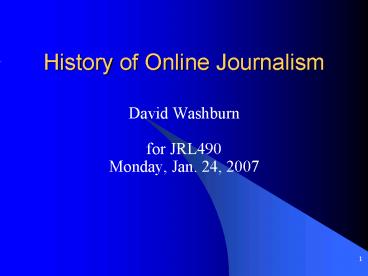History of Online Journalism - PowerPoint PPT Presentation
1 / 23
Title:
History of Online Journalism
Description:
British Broadcasting Corporation (BBC) files for patent of 'Teledata' in 1971 ... Star-Telegram posts its news and information AND it encouraged Startext users to ... – PowerPoint PPT presentation
Number of Views:2184
Avg rating:3.0/5.0
Title: History of Online Journalism
1
History of Online Journalism
- David Washburn
- for JRL490
- Monday, Jan. 24, 2007
2
Introduction
- Online journalism is, most importantly,
journalism. Online simply defines the method of
delivery. - In tonights session, you will come to understand
the roots of online journalism and how quickly it
has emerged. - Why did you select this class this semester?
3
Key pieces along the way
Bulletin Board Systems
Teletext
Videotext
Internet
Startext
World Wide Web
4
Roots of online journalism
- 1970
- 25 cents for a gallon of gas
- Vietnam
- IBM PC ...
- 10 years away
- Teletext
5
Teletext
- Noninteractive system for transmission of text
and graphics for display on a television set.
6
Teletext
- The TV set must be equipped with a decoder box or
built-in chip in order to capture and display the
teletext information. - British Broadcasting Corporation (BBC) files for
patent of "Teledata" in 1971 - Later that same year, Teletext tested in Reston,
Va.
7
Videotext
- Computer-based interactive systems that
electronically deliver - text
- numbers
- graphics
8
Videotext
- Via
- telephone lines
- two-way cable
- computer networks
- or any combination of the three
9
Videotext
- For display on a
- television set
- video monitor
- or
- a personal computer.
10
Videotext
- Every interactive online system that has existed,
including the Internet, falls under the videotext
umbrella.
11
Videotext
- However, videotext never gained popularity.
- What went wrong?
12
Videotext
- 1. Dedicated terminals were required for access.
- 900 to buy or 30 per month to rent
- 2. Tied up the family TV and telephone
- Most homes in the '70s and '80s had just one
phone line and one TV - 3. High cost and complex pricing
- Monthly fees plus additional costs based on usage
- 4. Poor messaging capabilities
- Email proved to be popular, and it clogged early
videotext systems
13
Bulletin Board Systems
- 1978 BBS software packages invented
- Personal computer can house a complete
interactive online system. Computer is hooked to
a modem and answers calls from other computers
for information -- news, email, discussion boards.
14
Bulletin Board Systems
- 1982 StarText, the only early newspaper
videotext system intended for display on
computers, opens in Fort Worth, Texas - 1985 IBM, Sears and CBS announce a partnership
to create Trintex, eventually renamed Prodigy. - StarText and Trintex were intended for delivery
to personal computers -- not television sets.
15
Bulletin Board Systems
- Star-Telegram posts its news and information AND
it encouraged Startext users to contribute
content to the online service. - User-contributed
- movie reviews
- columns
- short stories
- They built an active online community
16
What is the Internet?
- The Internet is
- a network of computers
17
What is the World Wide Web?
- Created in 1990 when Englishman Tim Berners-Lee
and colleagues at the European Center for
Particle Physics developed a computer language
that enabled users to navigate by clicking on
underlined words called links.
Tim Berners-Lee
18
What is the World Wide Web?
- The language
- Hypertext Markup Language.
19
What is the World Wide Web?
- The Web is a place where people do things
- buy airline tickets
- search for recipes
- read about disease
- read and interact with the news
- buy computers
- listen to the radio
- other things?
20
What makes the Web different?
- Capacity
- Nearly unlimited space, limited only by human
decisions and high-capacity servers - Flexibility
- words, pictures, audio, video, graphics
- Immediacy
- Information as events unfold
- Sept. 11, tsunami, hurricanes
- Breadth, or expansion (several angles to the same
topic) - Depth (quality and depth of information about an
individual story) - Permanence
- Nothing need be lost
- Interactivity
- Immediate feedback channel
- email links, forums, polls
21
Lessons learned
- Online services must be personally useful
- Popularity of email and search engines
- Interactivity is a key element
- weakness of traditional media, but not online
journalism - Content must be free unless it is very
specialized - Wall Street Journal sells subscriptions
- Ebay makes commissions
- Second layer (page 2) to espn.com
- Adult sites make money
- Real money is not in the technology but in the
programming - Advertisers will pay money if the audience is
there for the content
22
Summary
- Roots of the WWW go back three decades
- Like most inventions, the WWW was more like an
evolution than an invention - Teletext ? Videotext ? BBS ? WWW
- WWW gives journalists a new, unique and
interactive way to tell the story.
23
Bibliography
- Web Journalism Practice and Promise of a New
Medium by James Glen Stovall - Digital Journalism Emerging Media and the
Changing Horizons of Journalism, edited by Kevin
Kawamoto with a chapter by David Carlson - David Carlsons online timeline
(http//iml.jou.ufl.edu/carlson/timeline.shtml)































